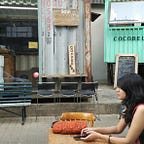Gestalt Principles Explained Through Gifs!
Let’s talk about the Gestalt Principles. These principles are all about how our brains group similar elements, recognize patterns and simplify complex images when we perceive objects. Our brains are masters at seeing the bigger picture from the comfort of our own minds. Gestalt principles help us understand the individual design choices we’ve been making come together and how users might interpret them.
Similarity
Elements that look similar by way of color, shape, size etc. are perceived to have the same function. Our brains are wired to group alike things together.
It’s like finding a group of identical socks in a world full of mismatched pairs. Our brains just can’t resist putting things that look alike together, creating a visual party where everything’s wearing the same outfit. In design it can be used to tie together elements that may not be located right next to each other. Color is perhaps the strongest indicator of similarity, as you can see from the gif below your brain instantly groups the circles and triangles by color despite being different shapes.
Proximity
Elements that are close together appear to be more related than elements that are spaced farther apart. It's similar to how we would perceive social cliques in a high school cafeteria. Objects that hang out close together are automatically grouped as the same. An interesting fact to note is that proximity is stronger than some of the other principles, for example the principle of similarity. It can help you guide the viewers direction.
Common Region
Elements located within the same area are perceived to be grouped together. In a complex UI with lots of components you can use background color or a border to group related items together. As an example, on Facebook, a post is grouped along with its likes and comments so they appear as one along with the content of the post. This way while scrolling through your feed you can clearly differentiate between posts. The same for any newsfeed really as shown below.
Closure
When a human looks at an incomplete object, they subconsciously complete the image to see a whole, completed object.
Our brains just can’t resist the urge to connect the dots and bring order to the chaotic world of visual perception. Closure: when our brains say, “I got this, I’ll finish it myself!”. In the world of design this is leveraged where images and text come together to form a logo e.g. the picture below is just a series of dots but your brain completes it to form a dog. Text is partially completed or awkwardly joined to have a hidden picture. It can also be used to indicate that there is more to see on the page so that the user intuitively scrolls or swipes to find it.
Continuity
Elements that are arranged in a line or on a curve appear to be more related than elements not on the line or curve.
Think of the Gestalt Principle of Continuity as the art of leading someone’s eyes like a mischievous tour guide. It’s like convincing your friend to follow you through a line of food stalls at a carnival, promising them the most delicious treats at the end. The key is to arrange those mouthwatering snacks in a straight line, making it impossible for your friend’s hungry eyes to resist the temptation. Just like that, with the magic of continuity, you’ll have them drooling and following your lead, one scrumptious treat at a time.
On a shopping app we can use this by lining up similar products together so the user knows they are related to each other and might be interested in purchasing them.
In conclusion, the Gestalt Principles offer us insight into the inner workings of our minds when it comes to perceiving the visual world around us. These principles, like the guiding hands of an artist, help us see order in chaos and patterns in randomness. The Gestalt Principles help designers create experiences that resonate with our perceptive faculties. By knowing them well, we can have some create delightful experiences by intentionally arranging elements to guide the user on an artful journey, like dotting breadcrumbs along a trail.
